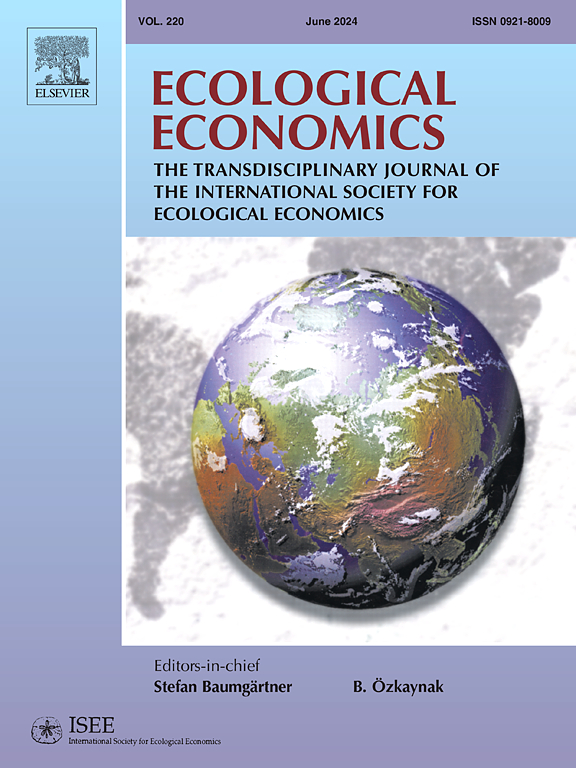Stated preferences for the colours, smells, and sounds of biodiversity
IF 6.3
2区 经济学
Q1 ECOLOGY
引用次数: 0
Abstract
Forest creation and restoration are embedded in global policy. Both result in landscape changes that have far-reaching socioeconomic consequences. However, there is limited evidence on public preferences for the biodiversity these forests contain. Here we used a choice experiment to explore the British public's willingness to pay (WTP) for different forest biodiversity attributes. We began with a multiple-step deliberative participatory process. This revealed that participants conceptualised forest biodiversity through visual, aural and olfactory senses. We subsequently developed and pre-tested sensory attributes based on colours, smells and sounds. Depending on the size of the proposed change, participants (N = 1711) were willing-to-pay for a greater variety of sensory attributes and for an indicator of improved ecological functioning (deadwood for decomposition). WTP for sensory attributes was influenced by participants' having related sensory impairments or visiting forests frequently. Our wider contribution highlights the importance of participatory methods to unearth novel and uncommon attributes that can then be used in stated preference studies. Ensuring that we evaluate stated preferences in a manner that reflects how the public conceives biodiversity is important if we are to improve the alignment between forest creation/restoration and public views, which could thus help bolster public support for the planning and implementation of landscape changes.
表示喜欢生物多样性的颜色、气味和声音
营造和恢复森林是全球政策的一部分。两者都会导致景观变化,产生深远的社会经济影响。然而,有关公众对这些森林所含生物多样性的偏好的证据却很有限。在此,我们使用选择实验来探索英国公众对不同森林生物多样性属性的支付意愿(WTP)。我们首先开展了一个多步骤的商议参与过程。结果显示,参与者通过视觉、听觉和嗅觉对森林生物多样性进行概念化。随后,我们开发并预先测试了基于颜色、气味和声音的感官属性。根据拟议改变的规模,参与者(N = 1711)愿意为更多种类的感官属性和改善生态功能的指标(用于分解的枯木)付费。参与者是否有相关的感官障碍或是否经常去森林对感官属性的 WTP 有影响。我们更广泛的贡献强调了参与式方法对于发现新颖和不常见属性的重要性,这些属性可用于陈述偏好研究。如果我们要改善森林创建/恢复与公众观点之间的一致性,确保我们以反映公众如何看待生物多样性的方式来评估陈述偏好是非常重要的,这将有助于加强公众对景观变化规划和实施的支持。
本文章由计算机程序翻译,如有差异,请以英文原文为准。
求助全文
约1分钟内获得全文
求助全文
来源期刊

Ecological Economics
环境科学-环境科学
CiteScore
12.00
自引率
5.70%
发文量
313
审稿时长
6 months
期刊介绍:
Ecological Economics is concerned with extending and integrating the understanding of the interfaces and interplay between "nature''s household" (ecosystems) and "humanity''s household" (the economy). Ecological economics is an interdisciplinary field defined by a set of concrete problems or challenges related to governing economic activity in a way that promotes human well-being, sustainability, and justice. The journal thus emphasizes critical work that draws on and integrates elements of ecological science, economics, and the analysis of values, behaviors, cultural practices, institutional structures, and societal dynamics. The journal is transdisciplinary in spirit and methodologically open, drawing on the insights offered by a variety of intellectual traditions, and appealing to a diverse readership.
Specific research areas covered include: valuation of natural resources, sustainable agriculture and development, ecologically integrated technology, integrated ecologic-economic modelling at scales from local to regional to global, implications of thermodynamics for economics and ecology, renewable resource management and conservation, critical assessments of the basic assumptions underlying current economic and ecological paradigms and the implications of alternative assumptions, economic and ecological consequences of genetically engineered organisms, and gene pool inventory and management, alternative principles for valuing natural wealth, integrating natural resources and environmental services into national income and wealth accounts, methods of implementing efficient environmental policies, case studies of economic-ecologic conflict or harmony, etc. New issues in this area are rapidly emerging and will find a ready forum in Ecological Economics.
 求助内容:
求助内容: 应助结果提醒方式:
应助结果提醒方式:


